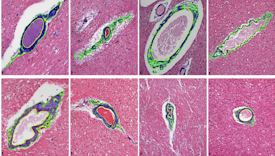Matthew P. Anderson is an associate professor at Harvard Medical School and principal investigator in the Departments of Pathology and Neurology and chief of neuropathology at Beth Israel Deaconess Medical Center. Anderson is also the clinical neuropathologist and Boston Node director for Autism BrainNet. Anderson obtained his M.D., Ph.D. at the University of Iowa College of Medicine, working with Howard Hughes Medical Institute (HHMI) investigator Michael J. Welsh, M.D., establishing the ion channel function and regulation of the cystic fibrosis gene, and his anatomic pathology residency at the University of Iowa Hospitals and Clinics. He did his neuropathology fellowship in the Longwood Neuropathology Training Program at Brigham and Women’s Hospital and Boston Children’s Hospital and Massachusetts General Hospital. He completed his mentored biomedical research training at Massachusetts Institute of Technology with Nobel Laureate and HHMI Investigator Susumu Tonegawa.
Anderson’s laboratory focuses on the molecular, immunologic and neuronal circuit bases of genetic forms of human neurological and psychiatric conditions including autism spectrum disorder, intellectual disabilities, obesity and epilepsy. The laboratory models specific human disease gene mutations or gene copy number variations using Cas9 editing to generate conditional molecular genetics models in the mouse, and investigates cellular and neuronal circuit functions and dysfunction using AAV viral vectors, biochemistry, transcriptional profiling, slice patch clamp electrophysiology, in vivo implanted mini-microscope imaging and behavioral analyses. Using these techniques, Anderson’s laboratory identified the first human genetic epilepsy disorder with defective postnatal developmental pruning and maturation of glutamatergic circuits (Zhou et al., Nature Medicine, 2009), and created the first genetic mouse model of a frequent and strongly penetrant genetic autism spectrum disorder (Smith et al., Sci. Transl. Med., 2011). They identified autism-related gene protein interaction and brain neuronal circuit networks involved in sociality in mice (Krishnan et al., Nature, 2017). Recently, they uncovered a cytotoxic T-cell immune response and damaged astrocytes at the glia limitans in a majority of autism spectrum disorder postmortem brains (DiStasio et al., Annals of Neurology, 2019). Anderson’s ultimate goal is to understand the pathophysiological mechanisms of these neurological conditions.
Anderson has served on advisory boards of the National Institutes of Health, American Epilepsy Society, Rett Syndrome Foundation and Nancy Lurie Marks Foundation; he has served as editor for multiple journals and has authored over 80 scientific chapters, reviews and manuscripts.



